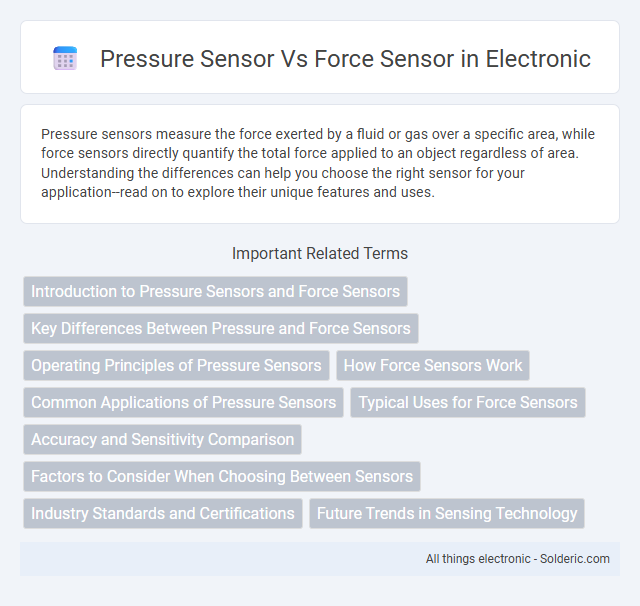Pressure sensors measure the force exerted by a fluid or gas over a specific area, while force sensors directly quantify the total force applied to an object regardless of area. Understanding the differences can help you choose the right sensor for your application--read on to explore their unique features and uses.
Comparison Table
| Feature | Pressure Sensor | Force Sensor |
|---|---|---|
| Definition | Measures pressure exerted by gases or liquids | Measures force applied on an object |
| Unit of Measurement | Pascals (Pa), psi, bar | Newtons (N), pounds (lbs) |
| Working Principle | Detects pressure changes via strain gauge, capacitive, or piezoelectric methods | Detects force via strain gauges, piezoelectric, or load cells |
| Applications | Weather monitoring, industrial process control, fluid flow measurement | Weighing scales, robotics, material testing |
| Measurement Range | From a few Pa to thousands of psi | From millinewtons to several kilonewtons |
| Output Signal | Analog or digital voltage/current proportional to pressure | Analog or digital voltage/current proportional to force |
| Sensitivity | High sensitivity to fluid and gas pressure changes | High sensitivity to mechanical load and force |
Introduction to Pressure Sensors and Force Sensors
Pressure sensors detect and measure the force exerted by a fluid or gas per unit area, converting it into an electrical signal for applications like weather monitoring and industrial control. Force sensors measure the total force applied to an object, often using strain gauges or piezoelectric materials, and are essential in robotics, biomechanics, and material testing. Both sensors rely on different principles and structures to quantify physical interactions, optimizing performance based on specific use cases.
Key Differences Between Pressure and Force Sensors
Pressure sensors measure the magnitude of a force applied over a specific area, providing data about fluid or gas pressure in systems. Force sensors directly measure the total force applied regardless of the contact area, often used for load or weight detection. Understanding these key differences helps you select the right sensor for accurate measurement in applications requiring precise force or pressure monitoring.
Operating Principles of Pressure Sensors
Pressure sensors operate by detecting the force exerted by a fluid or gas on a surface and converting this mechanical pressure into an electrical signal. Common operating principles include piezoresistive, capacitive, piezoelectric, and optical methods, each utilizing different physical properties to measure pressure changes accurately. These sensors are designed to respond to variations in pressure rather than direct mechanical force application, distinguishing them fundamentally from force sensors.
How Force Sensors Work
Force sensors operate by detecting the amount of force applied to an object, converting mechanical pressure into an electrical signal through strain gauges, piezoelectric elements, or capacitive components. These sensors measure compressive, tensile, or shear forces, providing precise data critical in applications like robotics, medical devices, and industrial automation. Understanding how force sensors function allows you to select the appropriate technology for accurate force measurement in your specific use case.
Common Applications of Pressure Sensors
Pressure sensors are widely used in automotive systems for monitoring tire pressure and engine performance, as well as in HVAC systems to regulate air flow and maintain optimal conditions. In industrial settings, these sensors detect fluid pressure in hydraulic systems and ensure safety in pneumatic controls. Your choice of pressure sensor will depend on the specific application requirements such as range, accuracy, and environmental conditions.
Typical Uses for Force Sensors
Force sensors are commonly used in robotics and industrial automation to measure applied force for precise control and safety. They are essential in medical devices for monitoring grip strength and detecting patient movement. In automotive testing, force sensors help assess crash impact and component durability for enhanced vehicle safety.
Accuracy and Sensitivity Comparison
Pressure sensors typically offer higher accuracy in measuring fluid or gas pressure changes due to their design to detect minute variations in pressure levels; force sensors, however, excel in sensitivity for mechanical load or force detection across a wide range of applications. Accuracy in pressure sensors is often quantified by parameters like non-linearity, hysteresis, and repeatability, whereas force sensors are evaluated based on resolution and sensitivity to small changes in applied force. Choosing between these depends on whether your priority is precise fluid/gas pressure measurement or detecting subtle force variations in a mechanical system.
Factors to Consider When Choosing Between Sensors
When choosing between a pressure sensor and a force sensor, consider the type of measurement required, as pressure sensors detect fluid or gas pressure while force sensors measure direct mechanical force or load. Sensitivity, response time, operating environment, and the sensor's range also impact the decision, with pressure sensors typically optimized for varying fluid pressures and force sensors designed for precise mechanical force detection. Application-specific factors such as size constraints, required accuracy, and compatibility with signal processing systems further influence the selection between these sensor types.
Industry Standards and Certifications
Pressure sensors and force sensors must comply with distinct industry standards and certifications tailored to their specific applications, such as ISO 17025 for calibration and ANSI/ISA standards for pressure instrumentation. Pressure sensors often adhere to standards like ASME B40.1 for pressure gauges and are certified for hazardous environments with ATEX or IECEx approvals. Force sensors typically meet ASTM E4 for force measurement and may require ISO 9001 certification to ensure quality management in manufacturing processes.
Future Trends in Sensing Technology
Future trends in sensing technology reveal increasing integration of pressure sensors and force sensors with advanced materials like graphene and flexible substrates, enhancing sensitivity and durability. The development of AI-driven data processing allows real-time analysis, improving applications in healthcare, robotics, and wearable devices. Miniaturization and wireless connectivity continue to drive innovation, enabling smart environments with precise force and pressure monitoring.
pressure sensor vs force sensor Infographic

 solderic.com
solderic.com